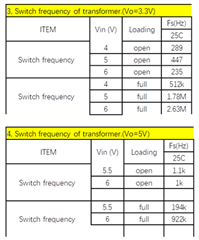Hi team,
I am having issues measuring over the switching frequency:
Their test results:


I can understand that under light load, the fsw is reduced to save power.
I have also read the following application note:
Understanding frequency variation in the DCS-Control(TM) topology
But below is what confuse me:
1. According to the application note, the switching frequency deviates under high duty cycle and low duty cycle. My understanding is that fsw deviates more away from standard value (2.4 MHz) as the duty cycle increase or decrease. But from customer's test results, the fsw is even lower at low duty cycle (see the form of Vo=1.8V).
2. TPS62085 supports 100% duty cycle operation according to the datasheet. Why is there still a minimum off-time? And what is the minimum off-time of TPS62085?
3. What is the specific "moderate" duty cycle range in the application note?
Thanks,
Frank



